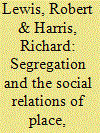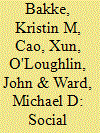| Srl | Item |
| 1 |
ID:
126170


|
|
|
|
|
| Publication |
2013.
|
| Summary/Abstract |
For many, a defining feature of the colonial Indian city is the high rate of segregation of its European and Indians residents. Building on recent work that explores the messy realities of social and spatial relations, this paper argues that the social geographies of the colonial city were built on the social relations of place-the network of social relations that are bound up with a particular material setting. The result was that social spaces were centred on overlapping geographic patterns, intense negotiations over space, and heterogeneous lived-in spaces. In this paper, these points are examined through the case of Bombay's Modern Town at the turn of the twentieth century. Modern Town was supposedly the home of the city's European population and it stood in sharp contrast to the city's Native Town. However, Modern Town did not conform to the spatial topographies described by most writers. While formal residential segregation existed, social and economic articulation and interaction ensured that the district's social spaces were meshed in differentiated and complex ways.
|
|
|
|
|
|
|
|
|
|
|
|
|
|
|
|
| 2 |
ID:
086960


|
|
|
|
|
| Publication |
2009.
|
| Summary/Abstract |
This article examines attitudinal differences and similarities among ethnic groups in conflict-affected societies. Conventional wisdom tells us that societies that have experienced violent struggles in which individuals of different ethnic groups have (been) mobilized against each other are likely to become polarized along ethnic lines. Indeed, both policy-makers and scholars often assume that such divisions are some of the main challenges that must be overcome to restore peace after war. We comparatively examine this conventional wisdom by mapping dimensions of social distance among 4,000 survey respondents in Bosnia-Herzegovina and the North Caucasus region of Russia. The surveys were carried out in December 2005. Using multidimensional scaling methods, we do not find patterns of clear attitudinal cleavages among members of different ethnic groups in Bosnia-Herzegovina. Nor do we find patterns of clear ethnic division in the North Caucasus, although our social distance matrices reveal a difference between Russians and ethnic minority groups.
|
|
|
|
|
|
|
|
|
|
|
|
|
|
|
|